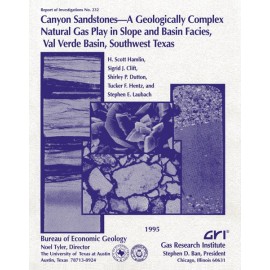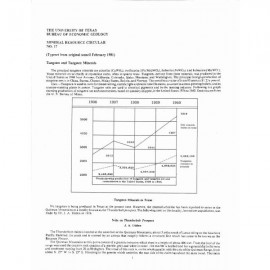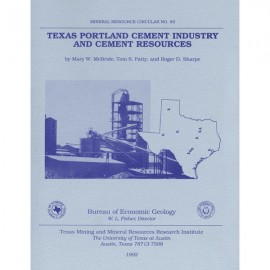Reports of Investigations
-
Books & Reports
- Reports of Investigations
- Guidebooks
- Udden Series
- Geological Circulars
- Down To Earth
- Atlases of Major Oil and Gas Reservoirs
- Texas Memorial Museum Publications
- Environmental Geologic Atlas of the Texas Coastal Zone
- Mineral Resource Circulars
- Other Reports
- Seminars and Workshops
- Handbooks
- Submerged Lands of Texas
- Symposia
- Annual Reports
- Open File Reports
-
Maps & Cross Sections
- Thematic Maps
- Miscellaneous Maps, Charts & Sections
- Geologic Atlas of Texas
- STATEMAP Project Maps
- Geologic Quadrangle Maps
- Cross Sections
- Highway Geology Map
- Energy and Mineral Resource Maps
- Shoreline Change and Other Posters
- Wilcox Group, East Texas, Geological / Hydrological Folios
- Bouguer Gravity Atlas of Texas
- River Basin Regional Studies
- Featured Maps
- Posters
- Teachers & the Public
-
Geological Society Publications
- Gulf Coast Association of Geological Societies
- Alabama Geological Society
- Austin Geological Society
- Corpus Christi Geological Society
- Houston Geological Society
- Lafayette Geological Society
- Mississippi Geological Society
- New Orleans Geological Society
- South Texas Geological Society
- GCS SEPM Publications
- Historic BEG & UT Series
Texas Miners Boost Talc Output
RI0035
This product is no longer in stock
RI0035. Texas Miners Boost Talc Output, by P. T. Flawn. 4 p., 2 figs. Reprinted from Engineering and Mining Journal, v. 159, no. 1, 1958.
EXCERPTED
Texas’ Hudspeth County talc mining, begun in 1952 when Southwestern Talc Corp. carried out pioneer exploratory operations, has expanded during the last five years and can today claim six active operations. These Include (1) Southwestern Talc Corp., Llano, Texas, (2) West Texas Talc Corp. (properties sold to the Milwhite Co., Inc., Houston, in October 1957), (3) Texas Talc Co., a subsidiary of Dallas Ceramic Tile Co., (4) Lone Star Mining Co., subsidiary of Royal Tile Manufacturing Co., Fort Worth, (5) Southern Clay Products Co., also known as Christian & Sons, Gonzales, Tex., (6) Glenn- Ray Corp., (Georgia Talc Co., Chatsworth Georgia, operator). Deposits occur within the Precambrian Allamoore formation in an area about 20 miles long in an east-west direction and 5 miles wide in a north-south direction. The Allamoore is a highly deformed and variably metamorphosed sequence of interlayered limestone and volcanic rocks, including thin beds of phyllite. The phyllite is commonly talcose—the amount of siliceous and calcareous impurities within the talc bodies shows wide variations. Phyllite units are mostly steeply dipping layers with a maximum thickness of about 200 or 300 ft which pinch and swell for a strike distance of up to several thousand feet. At Rossman mine (see map), two talc bodies occur as nearly vertical beds enclosed by cherty limestone members of the Allamoore formation. Except in the immediate vicinity of the talc, these limestones do not appear to be appreciably dolomitic. The main body is a tabular wedge-shaped unit about 7,000 ft long; it strikes about east-west, dips 70 degrees to 85 degrees south, and tapers from a width of 400 to 500 ft on the west to 100 to 200 ft on the east where it is cut off by a thrust fault. Talc is in contact with a small mass of diabase of uncertain age at orebody’s west end.
[The] problem of talc’s origin has not yet been solved. The Allamoore formation is composed mainly of interlayered cherty limestone and volcanic rocks, and beds of cherty carbonate rock are known to occur within bodies of talc. Pinching and swelling beds of foliated talc are concordant in the sedimentary sequence and show little variation over a strike distance of about 20 miles. There is no indication of origin through hydrothermal alteration of basic igneous rock either in the shape of the bodies or in the form of unaltered relicts. Detailed study of the talc bodies is necessary for a conclusive statement on their origin, but information available to date [1958] suggests an origin through alteration of sedimentary or pyroclastic rocks such as dolomitic marl or magnesium-rich tuff.
Keywords: talc, Allamoore Formation, mineral resources, Texas
Citation
Flawn, P. T., 1958, Texas Miners Boost Talc Output: The University of Texas at Austin, Bureau of Economic Geology, Report of Investigations No. 35, 4 p.






